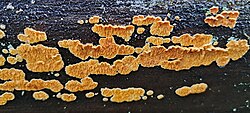| Pseudomerulius | |
|---|---|
 | |
| Pseudomerulius aureus | |
| Scientific classification | |
| Kingdom: | Fungi |
| Division: | Basidiomycota |
| Class: | Agaricomycetes |
| Order: | Boletales |
| Family: | Tapinellaceae |
| Genus: | Pseudomerulius Jülich |
| Type species | |
| Pseudomerulius aureus (Fr.) Jülich | |
| Species | |
Pseudomerulius is a genus of fungi in the Tapinellaceae family. The genus is widespread and contains two species. [1] P. aureus is noted as being inedible. [2]